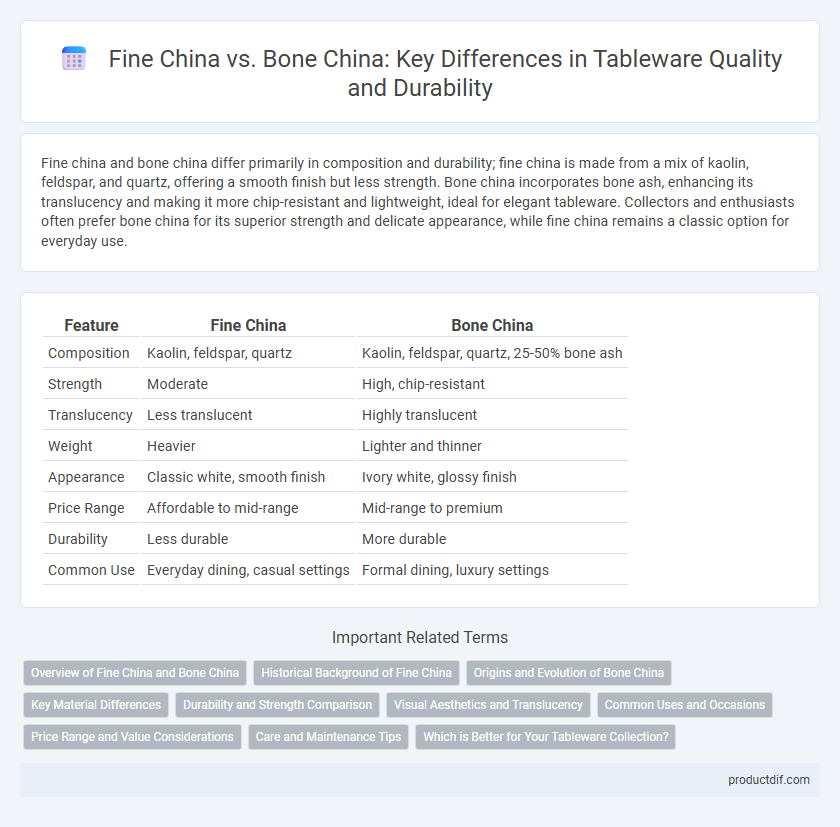Fine china and bone china differ primarily in composition and durability; fine china is made from a mix of kaolin, feldspar, and quartz, offering a smooth finish but less strength. Bone china incorporates bone ash, enhancing its translucency and making it more chip-resistant and lightweight, ideal for elegant tableware. Collectors and enthusiasts often prefer bone china for its superior strength and delicate appearance, while fine china remains a classic option for everyday use.
Table of Comparison
| Feature | Fine China | Bone China |
|---|---|---|
| Composition | Kaolin, feldspar, quartz | Kaolin, feldspar, quartz, 25-50% bone ash |
| Strength | Moderate | High, chip-resistant |
| Translucency | Less translucent | Highly translucent |
| Weight | Heavier | Lighter and thinner |
| Appearance | Classic white, smooth finish | Ivory white, glossy finish |
| Price Range | Affordable to mid-range | Mid-range to premium |
| Durability | Less durable | More durable |
| Common Use | Everyday dining, casual settings | Formal dining, luxury settings |
Overview of Fine China and Bone China
Fine China is a type of porcelain known for its delicate translucency, high fired temperature, and smooth, refined texture, typically made from kaolin clay. Bone China incorporates bone ash into its composition, resulting in a stronger, more chip-resistant material with a slightly warmer color and exceptional whiteness. Both types are prized in tableware for their elegance and durability, but Bone China often commands a higher price due to its superior strength and craftsmanship.
Historical Background of Fine China
Fine China originated in 18th-century Europe, particularly in Germany and England, where artisans sought to replicate the delicate translucency and durability of Asian porcelain. It was initially characterized by its high-quality kaolin clay and feldspar composition, providing both elegance and strength. Compared to Bone China, Fine China has a slightly less translucent appearance but remains prized for its refined craftsmanship and classic designs.
Origins and Evolution of Bone China
Bone China originated in England during the late 18th century as a refinement of traditional porcelain, incorporating bone ash to enhance translucency and strength. Its development was driven by potters like Josiah Spode, who perfected the formula combining bone ash, kaolin, and feldspathic materials. This innovation marked a significant evolution from Fine China, offering a more durable and delicate tableware option prized for its whiteness and chip resistance.
Key Material Differences
Fine China is primarily made from kaolin, feldspar, and quartz, resulting in a smooth, delicate texture with a translucent quality. Bone China contains bone ash, which enhances its strength, whiteness, and chip resistance, making it more durable than Fine China. This key material difference affects the overall weight, translucency, and durability of the tableware.
Durability and Strength Comparison
Bone china exhibits superior durability and strength compared to fine china due to its higher bone ash content, which enhances its resilience and chip resistance. Fine china, while elegant and delicate, is more prone to cracking and chipping under regular use. The unique composition of bone china allows it to withstand higher temperatures and mechanical stresses, making it the preferred choice for everyday luxury tableware.
Visual Aesthetics and Translucency
Fine China and Bone China both offer exquisite visual aesthetics, but Bone China is renowned for its superior translucency and delicate, almost ethereal appearance. The higher bone ash content in Bone China contributes to its refined whiteness and subtle glow when held against light, creating an elegant visual presence unmatched by Fine China. Fine China, though elegant with intricate patterns and designs, generally appears more opaque and heavier in comparison.
Common Uses and Occasions
Fine china is commonly used for formal dining occasions such as weddings, holiday dinners, and upscale restaurant service due to its elegant appearance and delicate craftsmanship. Bone china is popular for everyday use and special occasions alike because of its durability, chip resistance, and translucent quality, making it suitable for both casual family meals and celebratory events. Both types of tableware enhance presentation and dining experience, but bone china offers greater versatility across frequent or extended use.
Price Range and Value Considerations
Fine china generally offers a more affordable price range compared to bone china, making it a popular choice for budget-conscious consumers seeking elegant tableware. Bone china, composed of bone ash, provides superior strength, translucency, and a higher resistance to chipping, which justifies its premium pricing and long-term value. Collectors and frequent users often prioritize bone china for its durability and refined aesthetic, despite the higher initial investment.
Care and Maintenance Tips
Fine china requires gentle handling and hand washing with mild detergent to preserve its delicate glaze and intricate patterns, avoiding abrasive scrubbers that can cause scratches. Bone china is more durable but still benefits from hand washing and should never be exposed to sudden temperature changes to prevent cracking. Both types should be stored with protective padding and avoided in dishwashers or microwaves to maintain their elegance and longevity.
Which is Better for Your Tableware Collection?
Bone china is often considered superior for tableware collections due to its exceptional strength, translucency, and higher calcium phosphate content, which enhances durability and chip resistance compared to fine china. Fine china, made with kaolin and fired at lower temperatures, offers a slightly more delicate feel and can be more affordable, but it is less robust than bone china. Collectors prioritizing longevity and elegance typically prefer bone china for heirloom-quality dishes and formal dining settings.
Fine China vs Bone China Infographic

 productdif.com
productdif.com